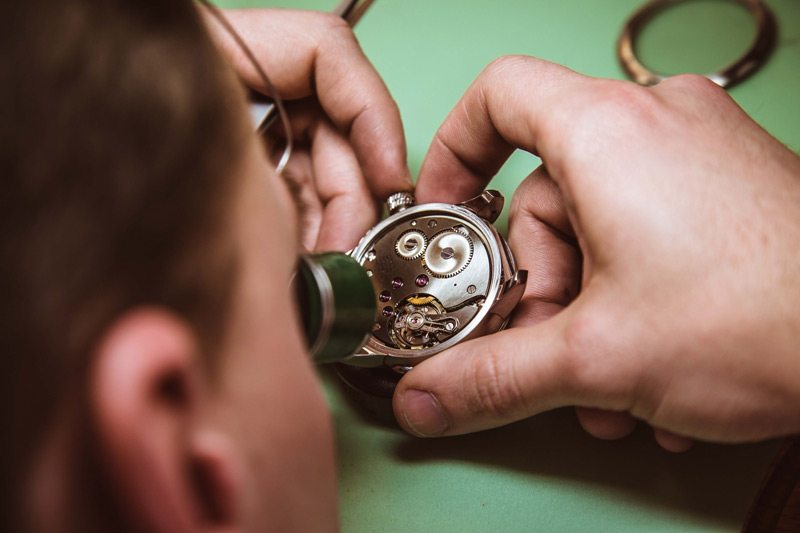In-house movements create a lot of conversation and raise a lot of questions. Is an in-house movement truly better? Is it really worth the markup? Also, is it reasonable to expect watch brands to own every single part of their production—especially when that wasn’t industry standard pre-Quartz Crisis? Given the state of the watch industry right now, probably not. But these are all good questions nonetheless.
Defining What “In-House” Means
Before we get in too deep, let’s straighten out some facts. Watch movements are difficult to produce at scale. Even the most basic mechanical movement has over 100 parts, and some contain over 1,000. Few companies have the capability or capital to produce all of the parts needed to make an entire watch movement within their own walls. And even the brands that produce true “in-house watch movements” still purchase certain highly-specialized parts from suppliers, including items like synthetic rubies, hair springs, and screws. In the end, brands pushing that “in-house” messaging are really just clever marketers. Which makes the debate all the more confusing.
Do conglomerates count?
These days, individual watch brands and parts suppliers belong to big luxury conglomerates like LVMH or Swatch Group. Which means that brands under one umbrella could claim to produce in-house movements because they source them from a supplier in the same family. ETA, owned by Swatch Group, sells its movements to companies like OMEGA and Hamilton, but neither brand will claim their ETA base calibers are in-house movements. So there’s clearly a limit to the definition. (Read: What is an ETA Movement?)

Swatch Group Headquarters
Design versus production
Sometimes, watch brands will actually design a movement in-house and have it produced elsewhere. This stretches the idea of in-house movements even further, since the production is exclusive to a brand, even if they don’t have the means to make it themselves.
Given the realities of watchmaking today, it just isn’t necessary for a watch company to produce 100% of its parts in-house. There’s no shame in outsourcing, even as the industry clings to its air of exclusivity and lack of transparency. So let’s establish a basic working definition for an in-house movement. Really, it’s a watch movement produced in a company’s own facilities using a majority of self-manufactured parts.
Does an In-House Movement Really Matter?
Beyond the aesthetics of a watch, what really matters most is how it functions. So you want a watch that keeps accurate time.
And despite what good copywriting and PR might tell you, you can’t guarantee that an in-house movement is going to be better quality than an outsourced one. Take ETA. Their movements are hard to beat in terms of reliability. They can be fine-tuned to run extremely accurately, parts and service are easy to find, and they’ll run almost indefinitely if cared for properly. Sure, an in-house movement may have higher-quality finishing, but does it really matter? Depends on your priorities.

Exclusivity and the Value of the “In-House” Label
Luxury watch brands love the idea of exclusivity. A watch with an in-house movement is automatically more “exclusive” than an outsourced movement from ETA, Sellita, or another supplier. It means that a company can charge more for the watch up-front, and it means they’ll have the only means of servicing it. It’s a good deal for a watch company.
But there’s also no denying that in-house movements are usually of high quality. Just look at Patek Philippe, Jaeger-LeCoultre and Rolex. They are universally acknowledged to produce incredibly superior movements. And Seiko produces all of its watches in-house at a much lower price point than the big luxury names.
On the other hand, many great watches house movements sourced from somewhere else. But they have to overcome buyer uncertainty. Who really wants to pay the same high price tag for a watch with an ETA movement inside? That’s what makes an in-house movement a worthy investment.
What About Pre-owned?
Of course, this whole debate on in-house versus outsourced movement—price and all—really only applies to brand new watches. When it comes to pre-owned, market forces are at play. Once a watch enters the pre-owned market, its value has depreciated and (generally) bottomed out. (Read: Which Watch Brands Hold Their Value the Most?) This evens out the price difference between a watch with an in-house movement and a watch without. At that point, you can do your own research—you’ll have plenty of resources to determine whether a watch with an in-house movement is really up to snuff.
Chances are, the debate won’t go away anytime soon. As Swatch Group continues to make ETA movements more difficult to obtain for outside companies and brands bring more affordable in-house movements to market, we’ll see a shift in the conversation. While the industry as a whole seems to be in a state of flux, we’re interested to see what “in house” will mean in the future.
Editor’s Note: This article was originally published on March 30, 2015. We have updated it for clarity.
Image Credits: Header,2; Crown & Caliber. 1; Swatch Group.
Get More Articles Like This in Your Inbox
We're constantly creating great content like this. So, why not get it delivered directly to your inbox? By subscribing you agree to our Privacy Policy but you can unsubscribe at any time.






